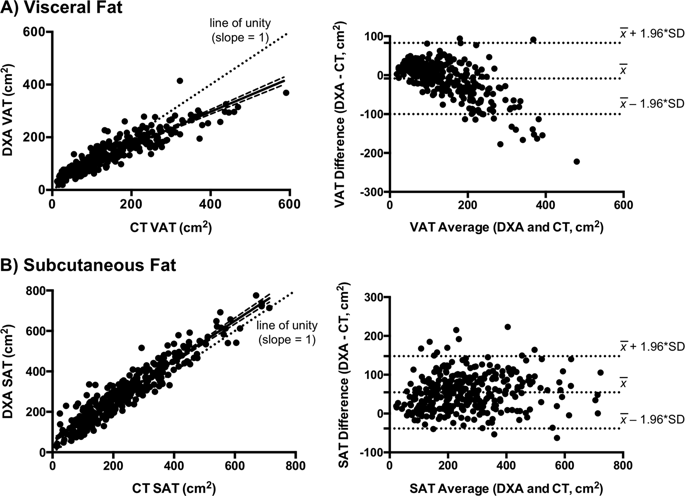当前位置:
X-MOL 学术
›
Nutr. Diabetes
›
论文详情
Our official English website, www.x-mol.net, welcomes your
feedback! (Note: you will need to create a separate account there.)
Comparison of visceral fat measurement by dual-energy X-ray absorptiometry to computed tomography in HIV and non-HIV.
Nutrition & Diabetes ( IF 4.6 ) Pub Date : 2019-02-25 , DOI: 10.1038/s41387-019-0073-1 Lindsay T Fourman 1 , Emma M Kileel 1 , Jane Hubbard 2 , Tara Holmes 2 , Ellen J Anderson 2 , Sara E Looby 1, 3 , Kathleen V Fitch 1 , Meghan N Feldpausch 1 , Martin Torriani 4 , Janet Lo 1 , Takara L Stanley 1 , Steven K Grinspoon 1
Nutrition & Diabetes ( IF 4.6 ) Pub Date : 2019-02-25 , DOI: 10.1038/s41387-019-0073-1 Lindsay T Fourman 1 , Emma M Kileel 1 , Jane Hubbard 2 , Tara Holmes 2 , Ellen J Anderson 2 , Sara E Looby 1, 3 , Kathleen V Fitch 1 , Meghan N Feldpausch 1 , Martin Torriani 4 , Janet Lo 1 , Takara L Stanley 1 , Steven K Grinspoon 1
Affiliation

|
BACKGROUND/OBJECTIVES
Individuals with HIV are susceptible to visceral fat accumulation, which confers an increased risk of cardiometabolic disease. Advanced software to ascertain visceral fat content from dual-energy X-ray absorptiometry (DXA) has not been validated among this population. We sought to compare DXA with computed tomography (CT) in the measurement of visceral fat cross-sectional area (VAT) in HIV and non-HIV using Bland-Altman analyses.
SUBJECTS/METHODS
Data were combined from five previously conducted studies of individuals with HIV (n = 313) and controls without HIV (n = 144) in which paired DXA and CT scans were available. In cross-sectional analyses, DXA-VAT was compared with CT-VAT among participants with and without HIV. In longitudinal analyses, changes in VAT over time were compared between DXA and CT among participants with and without HIV receiving no intervention over 12 months and among individuals with HIV receiving tesamorelin-a medication known to reduce VAT-over 6 months.
RESULTS
In HIV, DXA underestimated VAT compared with CT among individuals with increased visceral adiposity. The measurement bias was -9 ± 47 cm2 overall, but became progressively larger with greater VAT (P < 0.0001), e.g., -61 ± 58 cm2 among those with VAT ≥ 200 cm2. Sex-stratified analyses revealed that the relationship between VAT and measurement bias was especially pronounced in men (P < 0.0001). Longitudinally, DXA underestimated changes in VAT, particularly among those at the extremes of VAT gain or loss (P < 0.0001). In contrast to the cross-sectional findings, the tendency for DXA to underestimate longitudinal changes in VAT was evident in both men and women. Analogous findings were seen among controls in cross-sectional and longitudinal analyses.
CONCLUSIONS
DXA underestimated VAT relative to CT in men with and without HIV, who had increased visceral adiposity. DXA also underestimated changes in VAT over time in men and women, irrespective of HIV status. DXA-VAT should be used with caution among both HIV and non-HIV-infected populations.
中文翻译:

在艾滋病毒和非艾滋病毒患者中,通过双能X线骨密度仪和计算机断层扫描测量内脏脂肪的比较。
背景/目的艾滋病毒感染者易患内脏脂肪积聚,从而增加了心脏代谢疾病的风险。在该人群中,尚未通过先进的软件从双能X射线吸收法(DXA)确定内脏脂肪含量。我们试图使用Bland-Altman分析法将DXA与计算机断层扫描(CT)进行比较,以测量HIV和非HIV的内脏脂肪横截面积(VAT)。受试者/方法数据来自先前对患有HIV的个体(n = 313)和没有HIV的对照(n = 144)进行的五项研究,其中可进行DXA和CT配对扫描。在横断面分析中,将有和没有HIV的参与者的DXA-VAT与CT-VAT进行了比较。在纵向分析中,比较了DXA和CT在12个月内接受或不接受HIV干预的参与者与未接受干预的参与者以及接受tesamorelin(已知可在6个月内降低VAT的药物)的HIV个体之间的增值税变化。结果在HIV中,内脏脂肪增加的个体与CT相比,DXA低估了增值税。总体而言,测量偏差为-9±47 cm2,但随着增值税的增加,测量偏差逐渐增大(P <0.0001),例如,在增值税≥200 cm2的情况下,测量偏差为-61±58 cm2。性别分层分析显示,增值税和测量偏差之间的关系在男性中尤为明显(P <0.0001)。从纵向上讲,DXA低估了增值税的变化,尤其是在增值税增值或亏损极端情况下(P <0.0001)。与横截面的发现相反,无论男女,DXA都低估了增值税的纵向变化的趋势很明显。在横断面和纵向分析中,对照组之间也有类似的发现。结论DXA低估了相对于CT的男性和非女性,其内脏肥胖增加的增值税。DXA还低估了男性和女性的增值税随着时间的变化,而与HIV状况无关。在艾滋病毒和非艾滋病毒感染人群中应谨慎使用DXA-VAT。
更新日期:2019-02-25
中文翻译:

在艾滋病毒和非艾滋病毒患者中,通过双能X线骨密度仪和计算机断层扫描测量内脏脂肪的比较。
背景/目的艾滋病毒感染者易患内脏脂肪积聚,从而增加了心脏代谢疾病的风险。在该人群中,尚未通过先进的软件从双能X射线吸收法(DXA)确定内脏脂肪含量。我们试图使用Bland-Altman分析法将DXA与计算机断层扫描(CT)进行比较,以测量HIV和非HIV的内脏脂肪横截面积(VAT)。受试者/方法数据来自先前对患有HIV的个体(n = 313)和没有HIV的对照(n = 144)进行的五项研究,其中可进行DXA和CT配对扫描。在横断面分析中,将有和没有HIV的参与者的DXA-VAT与CT-VAT进行了比较。在纵向分析中,比较了DXA和CT在12个月内接受或不接受HIV干预的参与者与未接受干预的参与者以及接受tesamorelin(已知可在6个月内降低VAT的药物)的HIV个体之间的增值税变化。结果在HIV中,内脏脂肪增加的个体与CT相比,DXA低估了增值税。总体而言,测量偏差为-9±47 cm2,但随着增值税的增加,测量偏差逐渐增大(P <0.0001),例如,在增值税≥200 cm2的情况下,测量偏差为-61±58 cm2。性别分层分析显示,增值税和测量偏差之间的关系在男性中尤为明显(P <0.0001)。从纵向上讲,DXA低估了增值税的变化,尤其是在增值税增值或亏损极端情况下(P <0.0001)。与横截面的发现相反,无论男女,DXA都低估了增值税的纵向变化的趋势很明显。在横断面和纵向分析中,对照组之间也有类似的发现。结论DXA低估了相对于CT的男性和非女性,其内脏肥胖增加的增值税。DXA还低估了男性和女性的增值税随着时间的变化,而与HIV状况无关。在艾滋病毒和非艾滋病毒感染人群中应谨慎使用DXA-VAT。









































 京公网安备 11010802027423号
京公网安备 11010802027423号